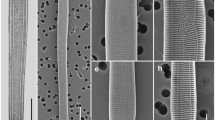Summary
The Pennales are diplonts and possess sexual, parthenogenetic or apogamous auxospore formation. Fusion is either isogamous or physiologically anisogamous.
Sexual reproduction among the Centrales, with the exception ofMelosira, is not fully understood. It is probable, however, that the Centrales are also diplonts. Contradicting claims of various authors can be explained through the assumption that the microspores are spermatozoids which fertilize the undivided contents of female cells (egg cells) and that the resulting zygotes develop into auxospores. Conclusive proof of this claim is lacking for neither do cytological investigations of reduction divisions which occur during microspore formation suffice in the matter, nor has fusion of the gametes been observed. InMelosira, which has no microspores, reduction division takes place in the mother cells before auxospore formation; two of the four nuclei fuse and the zygote develops into an auxospore.
The problems concerning sexual reproduction and alternation of nuclear phases among Centrales still remain unsolved except forMelosira. The Pennales, on the other hand, are definitely diploid.
Similar content being viewed by others
References
Bachrach, E., and Lefèvre, M. Contribution à l’étude du rôle de la silice chez les êtres vivants. Jour. Phys. Path. Gen.27: 1929.
—. Quelques observations sur les Diatomées nues. Rec. Trav. Crypt.1931: 281–287. 1931.
Cholnoky, B. v. Über die Auxosporenbildung vonAnomoeoneis sculpta E. Cl. Arch. Protistenkunde63: 23–57. 1928.
—. Beiträge zur Kenntnis der Auxosporenbildung. Arch. Protistenkunde68: 471–502. 1931.
—. Beiträge zur Kenntnis der Karyologie der Diatomeen. Arch. Protistenkunde80: 321–348. 1933.
—. Die Kernteilung vonMelosira arenaria nebst einigen Bemerkungen über ihre Auxosporenbildung. Zeits. Zellforsch. Mikrosk. Anat.19: 698–719. 1933.
Geitler, L. Die Reduktionsteilung und Kopulation vonCymbella lanceolata. Arch. Protistenkunde58: 465–507. 1927.
—. Über die Bedeutung der Grösse für die Organisation der Zelle. Naturwiss.18: 301–305. 1930.
—. Der Formwechsel der pennaten Diatomeen (Kieselalgen). Arch. Protistenkunde78: 1–226. 1932.
Hofker, J. Die Teilung, Mikrosporen- und Auxosporenbildung vonCoscinodiscus biconicus v. Breemen. Ann. Protistol.1: 167–194. 1928.
—. Über die Fortpflanzung einiger Diatomeen der Zuidersee. Zeits. Zellforsch. Mikrosk. Anat.10: 769–782. 1930.
Hustedt, F. Bacillariophyta (Diatomeae). In Pascher, A., Süsswasser Flora Mitteleuropas, Heft 10. 1930. pp. 466.
Korschikow, A. A. On the origin of the diatoms. Beih. Bot. Centr. Abt. 1.46: 460–469. 1930.
Liebisch, W. Experimentelle und kritische Untersuchungen über die Pektinmembran der Diatomeen unter besonderer Berücksichtigung der Auxosporenbildung und der Kratikularzustände. Zeits. Bot.22: 1–65. 1929.
Meyer, K. Über die Auxosporenbildung vonGomphonema geminatum. Arch. Protistenkunde66: 421–435. 1929.
Pascher, A. Über das Vorkommen von kontraktilen Vakuolen bei pennaten Diatomeen. Beih. Bot. Centr. Abt. 1.49: 703–709. 1932.
Persidsky, B. M. The development of the auxospores in the group of the Centricae. Moscow, 1929. pp. 15.
—. The sexual process inMelosira varians. Beih. Bot. Centr.53: Abt. A. 122–132. 1935.
Schmidt, P. Neue Ergebnisse zur Biologie und Karyologie derBiddulphia sinensis Greville. Flora28: 235–268. 1933.
Schreiber, K. Über Reinkulturversuche und experimentelle Auxosporenbildung beiMelosira nummuloides. Arch. Protistenkunde73: 331–345. 1931.
Smith, G. M. The freshwater algae of the United States. New York and London, 1933. pp. 716.
Author information
Authors and Affiliations
Rights and permissions
About this article
Cite this article
Geitler, L. Reproduction and life history in diatoms. Bot. Rev 1, 149–161 (1935). https://doi.org/10.1007/BF02870149
Issue Date:
DOI: https://doi.org/10.1007/BF02870149




